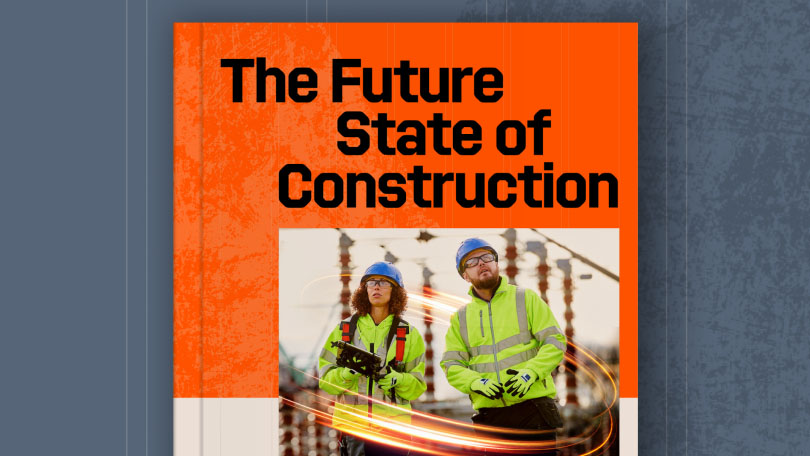— 12 min read
AI in Construction and the Built Environment


Last Updated Aug 28, 2025

Neil Thompson
Head of Digital Transformation
Neil has over 20 years experience in implementing technology in complex environments. From digital transformation in defence and strategic weapon systems, to robotics in nuclear waste management and the safe and secure use of AI in secure environments, he has a diverse background. He has recently moved from the UK to NZ to join Beca as their Head of Digital Transformation. Before embarking on his journey to NZ he was a member of the Department of Science, Innovation and Technology Expert Exchange Programme were he advised on the use of AI for the newly formed Regulation Innovation Office. Neil also led Digital Integration & Delivery for a national defence program that enabled digital engineering capabilities in both the management of infrastructure delivery and manufacturing systems. A notable previous role was the Head of the Construction Innovation Hub programme and a member of the executive team at the Centre for Digital Built Britain. Neil led the develop of many projects that dealt with implementing data and information management systems for national and local governments. Neil also led Digital Twin for UK & Europe for AtkinsRealis. Neil's expertise are focused on integrating digital infrastructure with engineering and social outcomes with a track record of balancing the tension between CTO/CDO type roles with CIOs, helping capital projects and delivery work seamlessly with operational environments.

Damon Schunmann
Journalist and Editor
Damon has been writing about the built environment for over 20 years, with over a decade of that as Associate Editor at Construction News. There he oversaw technical content, industry research and helped steer many of the conferences, awards and other events on behalf of CN. Thought leadership, analysis and project articles, papers and reports, events, video scripts and social media posts are all in his repertoire. Damon writes for informed industry audiences: where have ideas come from, what's innovative, how issues connect, who the key players are, how technologies work, structural and mechanical principles. Damon holds a Postgraduate Diploma in Journalism and a Master's Degree in Media and Communication. With a background in mechanical, military and civil engineering, Damon made the career shift to journalism in 2004, having realised it was far easier to write about construction than actually do it.

Zoe Mullan
27 articles
Zoe Mullan is an experienced content writer and editor with a background in marketing and communications in the e-learning sector. Zoe holds an MA in English Literature and History from the University of Glasgow and a PGDip in Journalism from the University of Strathclyde and lives in Northern Ireland.
Last Updated Aug 28, 2025

Artificial intelligence (AI) will transform UK construction and how we assess and interact with our built environment, bringing new efficiencies and insights once difficult to imagine. AI technologies now embed throughout the project lifecycle, from planning and design to construction and maintenance. Tools like machine learning, computer vision, and predictive analytics automate repetitive tasks, streamline project management, and improve on site safety.
However, AI adoption presents unique challenges. High implementation costs, skilled labour shortages for handling new technologies, and concerns around data privacy and security create notable hurdles. Additionally, AI systems in construction often require substantial amounts of data to function effectively, raising concerns over data management and accuracy. Nevertheless, guidance is emerging to help the industry embrace these seismic technological advances, such as the CIOB Artificial Intelligence (AI) Playbook 2024.
This article explores how AI reshapes construction processes across different implementation areas and their interconnections. It highlights both the advantages these technologies offer and the critical concerns regarding responsible AI that the industry must address as adoption accelerates.
Table of contents
AI Categories Used in Construction
The industry generally recognises four main AI categories, with the first two - documentation analysis and software automation - already widely adopted and readily available.
The third category focuses on computer vision - AI interpreting images and video - and sensor fusion, which integrates data from multiple sources such as cameras, Light Detection and Ranging (LiDAR), and environmental sensors. The fourth category comprises robotics applications. Both these categories represent emerging capabilities still developing in complexity and scale.
Significant challenges emerge as AI shifts from assisting with existing workflows to enabling autonomous agents (i.e., computational systems) and automation. The industry must address issues of trust, liability, and governance, particularly concerning insurance, risk management, and unionised labour roles. AI and robotics aim not to replace jobs but rather to augment the workforce by reducing hazardous tasks and upskilling workers for higher-value roles.
Despite AI's rapid progress, construction's unpredictable nature remains a significant barrier to full automation. Construction sites are dynamic, with shifting conditions difficult to model accurately using traditional AI systems. This unpredictability highlights the potential role of quantum computing in overcoming computational limitations and advancing AI's capabilities in construction.
Contemporary computing power is defined by a linear relationship of digitally processing noughts and ones. With quantum, you can calculate multiple states instantaneously in one instance.

Neil Thompson
Head of Digital Transformation
Beca
Category 1: AI for Documentation and Text Analysis
This category focuses on improving efficiency in document-heavy processes, such as contract management, compliance checks, and public consultation reviews. AI tools include large language models (LLMs), which have trained on vast amounts of text data, allowing them to understand and generate human-like language. They assist by analysing, summarising, and categorising text-based information. These models streamline workflows without fundamentally changing the nature of construction documentation.
In a construction context, large language models can assist with written documentation, such as proofreading, quality checking, and information retrieval.

Neil Thompson
Head of Digital Transformation
Beca
An example includes using AI to analyse public feedback on infrastructure projects. Traditionally, engineers manually review and categorise thousands of survey responses. AI-powered models trained on industry-specific language can automate this process, reducing workload while still requiring human oversight to ensure accuracy.
Beyond public consultation, AI enhances compliance documentation, safety reporting, and contract analysis by improving data accessibility and reducing administrative burdens.
Category 2: AI for Software Development and Automation
AI already automates elements of software development, enhancing design tools and streamlining repetitive coding tasks. While AI does not replace human engineers, it speeds up processes by translating high-level requirements into structured outputs, allowing faster iteration and greater precision.
An example of this second category is using AI to help generate 3D models and designs, rather than having to manually model everything. The AI can take high-level requirements and translate them into structured outputs.

Neil Thompson
Head of Digital Transformation
Beca
Generative design tools exemplify AI's role in construction software. Engineers input design parameters, and AI suggests optimised layouts based on material properties, structural integrity, and environmental conditions. Tools like generative design platforms demonstrate how AI assists rather than replaces human decision-making in architecture and engineering.
Category 3: AI for Computer Vision and Sensor Fusion - Emerging Technology
Moving beyond text and code, this category leverages AI to process visual and sensory data for monitoring, quality control, and safety analysis. Computer vision enables AI to detect defects, track progress, and improve site safety. Sensor fusion provides a more comprehensive understanding of construction sites and asset performance.
Feature recognition appears commonly in CCTV systems, road condition surveys, and mobile devices, where AI can identify faces, objects, and environmental factors. In construction specifically, feature recognition technology increasingly enables technical applications like asset condition assessment. AI can now analyse high-resolution images of structures to detect defects like cracks in concrete, corrosion in steelwork, or water ingress in buildings, helping engineers identify maintenance needs earlier and more accurately.
This category is about using AI for advanced data processing and analysis, going beyond just written documentation or software code. It’s about leveraging AI to extract meaningful insights and information from diverse data sources.

Neil Thompson
Head of Digital Transformation
Beca
For example, AI-driven computer vision can analyse bridge structures by detecting micro-movements that indicate stress or fatigue, reducing the need for manual inspections. Digital Image Correlation (DIC) techniques, such as those developed by AtkinsRéalis, use high-resolution imaging to track millimetre-scale deformations in infrastructure.
Sensor fusion also plays a role in smart buildings, where AI integrates occupancy data, temperature, and humidity readings to optimise energy efficiency and indoor conditions. As these technologies evolve, AI's ability to recognise and interpret complex structural and environmental data will improve further, offering valuable intelligence for asset management and predictive maintenance.
Category 4: AI Integration for Automation and Robotics - Emerging Technology
This category represents the convergence of AI capabilities from documentation, software automation, and sensory analysis into physical automation and robotics. AI-driven construction equipment, such as autonomous machinery and robotic arms, begins to take on repetitive or hazardous tasks, improving productivity and safety.
The challenge is often not the technical capability, but the governance, liability, and insurance issues around deploying such autonomous physical systems in construction environments.

Neil Thompson
Head of Digital Transformation
Beca
The industry deploys robotics in limited but growing ways, such as automated bricklaying and AI-assisted drilling robots like Hilti’s Jaibot. In another example at the former Sellafield nuclear power station, AtkinsRéalis has used autonomous drones and Boston Dynamics’ robot dog ‘Spot’ to survey higher-risk areas and provide virtual site access. Also at Sellafield, AtkinsRéalis has collaborated to integrate advanced hardware and software with the Kinova robot arm to develop a working prototype system capable of performing activities that would otherwise require human hands.
However, complex, unpredictable site conditions continue to limit fully autonomous construction. Unlike controlled environments like warehouses, construction sites change daily due to weather, logistics, and unforeseen obstacles.
This unpredictability presents a major challenge. AI models rely on structured data, but construction environments introduce too many unknown variables for current AI systems to manage effectively. While AI-powered robotics will continue to augment skilled labour by reducing hazardous tasks, full automation of construction processes remains a long-term goal.
Quantum Computing in Construction AI
AI-driven construction faces a fundamental challenge: accurately modelling the dynamic nature of building sites. Traditional computing analyses data sequentially, while real-world construction conditions change constantly and unpredictably.
Quantum computing presents a breakthrough solution through its ability to perform simultaneous calculations across multiple states. This capability could revolutionise how AI handles construction complexities, enabling sophisticated simulations, risk modelling, and predictive maintenance.
With quantum AI, construction simulations could process millions of environmental and logistical variables in real time, dramatically enhancing generative design, project scheduling, and materials optimisation beyond current capabilities.
Though quantum computing technology remains in early development, its future integration with AI promises to transform construction planning and execution over the coming decades.
A Structured Approach to AI Adoption
Construction companies widely use the first two AI categories - documentation and software automation - to enhance efficiency and decision-making. Meanwhile, the emerging categories - computer vision, sensor fusion, and robotics - show significant potential despite current technical and regulatory limitations.
As AI evolves from workflow assistance to autonomous operation, construction companies face critical challenges involving trust, insurance liability, and workforce integration. Rather than hindering adoption, unionised labour serves as a crucial ally in successfully implementing these technologies. AI and robotics will ultimately complement human workers by creating upskilling opportunities and reducing exposure to hazardous tasks.
Full AI automation in construction remains distant until systems can effectively model the sector's inherent unpredictability. Quantum computing may provide the breakthrough needed to overcome these computational barriers, enabling more sophisticated AI-driven construction solutions.
Responsible AI and Governance
Transparency and Accountability
The construction industry must resolve critical questions about accountability for AI system decisions and actions through careful, ongoing assessment and proper governance frameworks.
Data Ownership and Storage
Pressing questions are emerging about who owns the data used to train AI models, and where and how that data is stored.
Automation Versus Autonomy
A distinction exists between automating certain tasks versus giving AI systems full autonomy to make decisions without human intervention, and the governance around this is critical. Depending on the scenario, a framework may be required to regularly validate the outputs against human-checked samples.
Despite the benefits of automation, a human-in-the-loop process allows experts to review and validate AI-generated recommendations before finalisation. This provides an additional layer of oversight and quality control.Bias
Identifying and mitigating any potential bias that could be introduced into solutions, such as with AI categorisation of a public consultation survey, remains important. This means putting guardrails in place to ensure the solution correctly addresses all the risks.
Privacy and Data Handling
Excluding any personal or sensitive information from data being analysed by generative AI models is important for protecting individual privacy.
Pace of Change
AI is advancing rapidly, much faster than the ability of governments and organisations to put proper governance frameworks in place. Keeping up with the pace of change presents an ongoing challenge.
Potential for Misuse
AI models can be easily created and potentially misused to generate fake content. This presents serious security concerns across all sectors, particularly for sensitive domains like national infrastructure.
The safe and secure use of AI clearly requires robust governance frameworks to address such issues. Moreover, it must remain a crucial focus for the industry, as organisations throughout the construction supply chain deploy AI.
AI Applications in Construction
Scheduling
AI enhances construction scheduling by converting inputs into code-based schedules far more efficiently than manual methods. These systems also identify potential conflicts, improving schedule accuracy and reliability.
Data quality remains a key challenge, however. Construction schedules often contain inaccuracies and "fudge factors" that misrepresent reality. AI processing can amplify these inconsistencies rather than correct them.
Project terminology variations complicate matters further. For example, models built for railway projects typically fail when applied to airport construction because each sector uses different terms for similar elements and processes.
Therefore, while AI can assist with scheduling tasks, the quality and reliability of the underlying data is critical. Human expertise is still currently required to properly interpret the AI-generated outputs and ensure they accurately reflect the realities of a given construction project.

Neil Thompson
Head of Digital Transformation
Beca
Documentation Checking
Civil nuclear projects, for example, now require detailed safety documentation for nuclear material management. Identifying the impact of any changes is essential - often requiring extensive analysis spanning 12-24 months - and must be assessed alongside thorough testing. AI can assist with complex tasks like reviewing extensive documentation.
Real-World Application: Computer Vision in Transportation Infrastructure
Computer vision revolutionises infrastructure monitoring by providing a cost-effective, non-intrusive method to assess the performance of structures like bridges. Traditional techniques for monitoring structural deterioration, such as measuring deflection and strain, prove costly and disruptive.
Digital Image Correlation (DIC), developed by AtkinsRéalis, overcomes these challenges using cameras, including drones and smartphones, to capture high-resolution images that precisely measure movements and deflections. This enables engineers to assess stress, fatigue, and overall behaviour without physical contact or traffic disruptions, improving safety and reducing costs.
DIC has proven effective in various projects, including the Docklands Light Railway in London, where it helped avoid unnecessary bridge strengthening. Other applications include monitoring deflection on the Humber Suspension Bridge and validating questionable accelerometer (structural behaviour) readings on the Great Belt Suspension Bridge in Denmark. In the rail sector, DIC has led to multimillion-pound savings by optimising the clearance requirements for overhead line equipment on bridges, reducing the need for costly bridge reconstructions.
Moreover, a mobile app enhances DIC's accessibility, allowing engineers to quickly capture and analyse structural data, making inspections faster and more efficient. This innovation extends asset life, reduces carbon footprints, and ensures better asset management through accurate, real-time structural performance insights.
Future Construction Trends
The combination of AI and quantum computing will likely significantly enhance the construction industry's ability to manage complexity, optimise processes, and improve safety and sustainability in the coming decade.
Contemporary computing power is defined by a linear relationship of digitally processing noughts and ones. With quantum you can calculate multiple states instantaneously in one instance.

Neil Thompson
Head of Digital Transformation
Beca
Advances in quantum computing will enable faster simulation and modelling of complex construction systems and processes, and we will see increased use of AI for automating generative design options, enabled by more accessible generative design tools.
The ability of quantum computing plus AI to simulate the outcomes of critical infrastructure is going to be profound.

Neil Thompson
Head of Digital Transformation
Beca
Digital twins, virtual representations of physical objects like buildings, can provide huge advantages for efficient design, delivery and operation of built assets. Their sophistication and usefulness will be augmented through AI-powered feature recognition and sensory fusion, providing multiple enhancements, such as enabling predictive maintenance.
Meanwhile, AI-powered project management and scheduling tools will leverage improved data quality and analysis capabilities. Additionally, broader implementation of AI-based assistants and natural language processing will streamline documentation management and communication between project stakeholders.
On a more physical level, construction sites will benefit from the long-anticipated yet increasingly imminent integration of AI-driven automation and robotics for construction tasks like digging, lifting, and material handling.
These advances bring significant risks alongside their benefits. For example, quantum computing has the potential to break current encryption methods, requiring new approaches to data security and integrity in construction.
Categories:
General Industry, Preconstruction, Project Management, Tech and Data
Written by

Neil Thompson
Head of Digital Transformation | Beca
Neil has over 20 years experience in implementing technology in complex environments. From digital transformation in defence and strategic weapon systems, to robotics in nuclear waste management and the safe and secure use of AI in secure environments, he has a diverse background. He has recently moved from the UK to NZ to join Beca as their Head of Digital Transformation. Before embarking on his journey to NZ he was a member of the Department of Science, Innovation and Technology Expert Exchange Programme were he advised on the use of AI for the newly formed Regulation Innovation Office. Neil also led Digital Integration & Delivery for a national defence program that enabled digital engineering capabilities in both the management of infrastructure delivery and manufacturing systems. A notable previous role was the Head of the Construction Innovation Hub programme and a member of the executive team at the Centre for Digital Built Britain. Neil led the develop of many projects that dealt with implementing data and information management systems for national and local governments. Neil also led Digital Twin for UK & Europe for AtkinsRealis. Neil's expertise are focused on integrating digital infrastructure with engineering and social outcomes with a track record of balancing the tension between CTO/CDO type roles with CIOs, helping capital projects and delivery work seamlessly with operational environments.
View profile
Damon Schunmann
Journalist and Editor | Freelance
Damon has been writing about the built environment for over 20 years, with over a decade of that as Associate Editor at Construction News. There he oversaw technical content, industry research and helped steer many of the conferences, awards and other events on behalf of CN. Thought leadership, analysis and project articles, papers and reports, events, video scripts and social media posts are all in his repertoire. Damon writes for informed industry audiences: where have ideas come from, what's innovative, how issues connect, who the key players are, how technologies work, structural and mechanical principles. Damon holds a Postgraduate Diploma in Journalism and a Master's Degree in Media and Communication. With a background in mechanical, military and civil engineering, Damon made the career shift to journalism in 2004, having realised it was far easier to write about construction than actually do it.
View profileReviewed by

Zoe Mullan
27 articles
Zoe Mullan is an experienced content writer and editor with a background in marketing and communications in the e-learning sector. Zoe holds an MA in English Literature and History from the University of Glasgow and a PGDip in Journalism from the University of Strathclyde and lives in Northern Ireland.
View profileExplore more helpful resources

Control the Chaos: Standardising Document Workflows in Construction Projects
Document control and implementation play a central role in managing risk, meeting deadlines, and delivering projects to spec. As builds become more complex and teams increasingly disperse, the volume and...

Cost-Plus Construction Contracts in the UK
A construction cost-plus contract – sometimes called a cost-reimbursable or prime cost contract – reimburses all project costs and adds a fee to cover the contractor’s overhead and profit. UK...

Digital Construction Technology for Whole-Life Value
For decades, the construction industry has kept a narrow focus on capital cost — the one-time, upfront costs of a construction project. While in the short term this seems like...

UK Construction Progress Reports: Tools for Smarter Site Management
Construction progress reports track completed work, on site issues, costs, and safety so UK project teams can demonstrate progress, secure payments, and stay on programme. Accurate progress data is essential...
